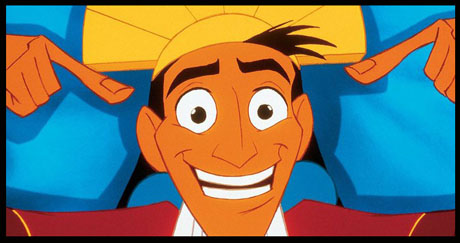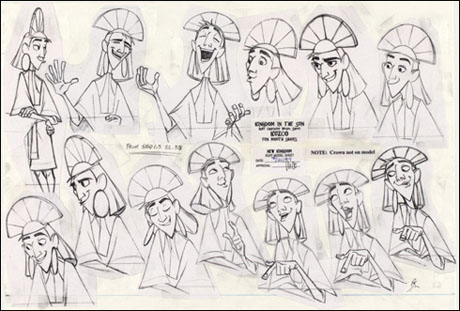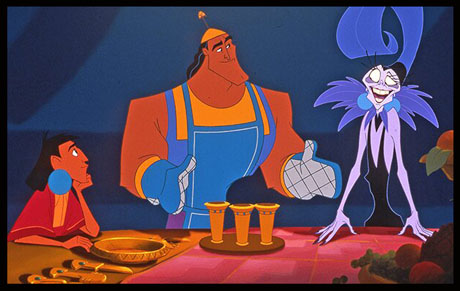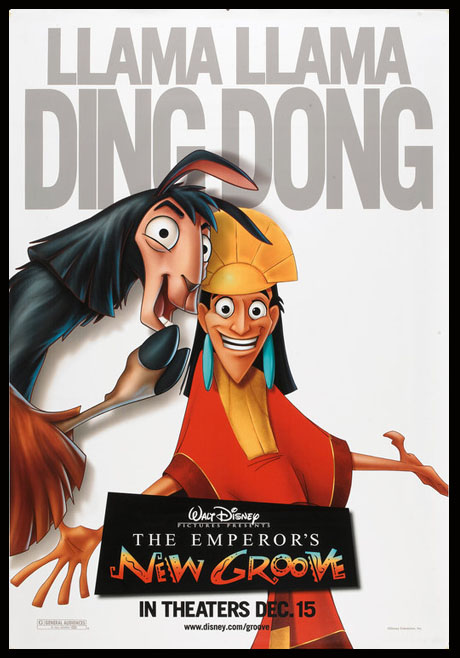
From a movie production filled with drama came a film filled with laughs. Disney’s 40th animated feature, The Emperor’s New Groove, which celebrates its 20th anniversary this month, started life as a completely different movie that became mired in problems, but emerged as one of the funniest films ever to come out of the Studio.
The film’s Producer Randy Fullmer recalled in an interview in 2000, “The first two years we were working on this film, people were pouring out their hearts and souls, trying to make a good movie. We eventually just took a step back and said, ‘We are really on the wrong track.’”

That original movie was Kingdom of the Sun, a re-telling of The Prince and the Pauper, set against Incan culture. It was to be a sweeping, epic musical, featuring songs written by Sting. During production, however, there were challenges with the story and early test screenings didn’t go well. This led to a difficult decision to shut down the film (after dialogue and music had been recorded and more than a third of the movie had been animated) and re-fashion it completely.
Fullmer remembered, “We said, ‘Let’s just strip it out, give it a clean, graphic look and turn it into more of a character piece.”
The revisions were drastic, a complete shift in story and tone, with the majority of the characters removed, as well as most of the songs Sting had written for the film. Additionally, one of the film’s original two directors, Roger Allers, left the project. This entire creative (and, at times, painful) process and production was documented by Sting’s wife Trudy Styler in her compelling 2002 documentary The Sweatbox.
The film that emerged on the other side of all of this was The Emperor’s New Groove. Set in a fictional South American kingdom, the new version would focus on the self-centered Emperor, Kuzco (voiced by David Spade), who is mistakenly transformed into a llama by his scheming advisor, Yzma (Eartha Kitt) and her dim-witted sidekick, Kronk (Patrick Warburton, in one of animation’s funniest vocal performances). Kuzco had fired Yzma and this was her revenge.

Kuzco, however, isn’t an innocent victim here, as he is simply focused on himself and looking to transform a section of his kingdom into his summer house, “Kuzcotopia,” displacing many from their home, including the kind-hearted peasant, Pacha (John Goodman), who agrees to help llama Kuzco get back to his human form, in exchange for keeping his home as is.
“This is something that’s not your typical Disney feature,” stated Kuzco animator Nik Ranieri, back in 2000. “This is a smaller picture, sort of like a Dumbo. It’s full of personality, plenty of humor and there’s still heart in it. It takes chances and goes where few animated films, that we’ve ever done, have gone before.”
Although The Emperor’s New Groove comes from the Studio synonymous with pixie dust and fairy tales, this film’s sensibilities are more in line with the off-the-wall tone of Warner Bros.’ Looney Tunes, or even MGM’s classic Tex Avery cartoons.
This shift was, in large part, the vision of director Mark Dindal (who remained on the project after Allers left). Dindal had just helmed Cat’s Don’t Dance (1997) for Turner Feature Animation and would go on to direct 2005’s Chicken Little for Disney. Both films, like The Emperor’s New Groove, balance the hysterical with heart.
“I like the challenge of getting emotion out of characters that are done without realism in mind,” noted Dindal, just prior to the release of The Emperor’s New Groove. “There’s dimension in the characters and all the animators apply the traditional rules to them. But, when you can take something that’s far-out in the imagination and still get a heartfelt moment, it’s an interesting combination.”
The Emperor’s New Groove walks this line perfectly. There are well-timed one-liners and sight gags throughout that harken back to the Golden Age of Animation Comedy. In an early scene, as an obnoxious Kuzco reviews potential brides (who all look alike), he states as he walks past the line-up: “Hate your hair. Not likely. Yikes. Yikes. Yikes. And, let me guess, you have a great personality.”

The movie even breaks out classic cartoon comedy “tropes,” like the “angel and devil on the shoulders” and characters being struck by lightning and then turning to a burnt crisp.
The Emperor’s New Groove balances these scenes with heart as seen through Kuzco and Pacha’s growing friendship, which leads to Kuzco’s ongoing realization of just how wrong and self-centered he has been.
Helping to shape this, were the actors who lent their voices to the characters. Spade brought his “snarkiness” to a new level as Kuzco and Goodman added warmth to Pacha. On the other side of the spectrum, Eartha Kitt’s distinctive, rich voice brought an extra note of diva to Yzma. “She was incredible,” said Yzma’s supervising animator Dale Bear, just after the film’s production. “Not just watching her recording sessions, but listening to them, you got a very distinctive picture in your mind. It just made coming up with ideas for her scenes that much more fun.”
Stealing scenes from a character like Yzma isn’t easy, but her sidekick Kronk most definitely accomplished this. This was the combination of Warburton’s deep voiced, clueless performance coupled with the work of supervising animator Tony Bancroft. “He’s a guy who could have a good legal battle with his career counselor,” laughed Bancroft, when discussing Kronk back in 2000. “He wasn’t given good advice when someone told him to pursue a career as a villain’s sidekick. He’s really a good-hearted guy, definitely more brawn than brain, but still a good guy.”
Kronk was so popular with audiences in fact, that the character was given his own direct-to-video sequel, Kronk’s New Groove, which debuted five years later, along with an animated series on The Disney Channel, The Emperor’s New School. Both are examples of how appreciation for The Emperor’s New Groove has grown through the years.

When the film debuted on December 15th, 2000, it was not the hit that Disney had hoped for throughout the production’s “ups and downs.” The Emperor’s New Groove debuted at a disappointing number four opening weekend and was coupled with a restrained marketing campaign (the only real “products” out at the time were Happy Meal toys at McDonald’s).
It wasn’t until spring of 2001, when the film debuted on home video that audiences began to realize just how funny, special and unique The Emperor’s New Groove is. In fact, the movie’s DVD became the top-selling home video release of 2001.
And, in the past two decades appreciation for The Emperor’s New Groove has grown and continues to. It’s also probably become the most quoted Disney animated film of all time, thanks to its comedically sharp sensibility.
“This film is like something from the Zucker Brothers, like Airplane with its non-sequiturs,” said Pacha’s supervising animator Bruce Smith back in 2000. “That’s never been done before in animation. We loved the cartoon aspect of it all.”
The increasing popularity of The Emperor’s New Groove through the years has also led to renewed support from the Disney company. A search on ShopDisney.com (Disney’s online store) brings up T-shirts, coffee mugs and pins (many of them themed to the 20th anniversary).
Those that created The Emperor’s New Groove however, knew just how special it was twenty years ago, as Randy Fullmer remembered, “Most of the animators have said that they had been waiting ten years to work on a film like this.”
- An Eye for A Classic: The 60th Anniversary of “Mr. Magoo’s Christmas Carol” - December 22, 2022
- A Very Merry Mickey: The 70th Anniversary of “Pluto’s Christmas Tree” - December 19, 2022
- A Fine French Feline Film: The 60th Anniversary of “Gay Pur-ee” - December 12, 2022


 December 25th, 2020
December 25th, 2020  Michael Lyons
Michael Lyons  Posted in
Posted in  Tags:
Tags: 






